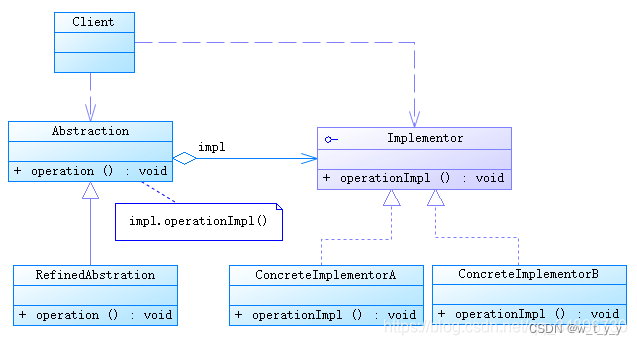一、介绍:
1、定义:桥接(Bridge)模式属于结构型设计模式。通过提供抽象化和实现化之间的桥接结构,来实现二者的解耦。把抽象(abstraction)与行为实现(implementation)分离开来,从而可以保持各部分的独立性以及应对它们的功能扩展。简而言之,实现系统可能有多角度分类,每一种分类都有可能变化,那么就把这种多角度分离出来让他们独立变化,减少他们之间的耦合。
2、组成结构:UML结构图如下:

(1) Abstraction(抽象类):它是用于定义抽象类的接口,通常是抽象类而不是接口,其中定义了Implementor(实现类接口)类型的对象并可以维护该对象,它与Implementor具有关联关系,它既可以包含抽象业务方法,也可以包含具体业务方法。
public abstract class Abstraction{
private Implementor impl;//定义实现类接口对象
public void setImpl(Implementor impl){
this.impl = impl;
}
public abstract void operation();//声明抽象业务方法
}
(2) RefinedAbstraction(扩充抽象类):它扩充由Abstraction定义的接口,通常情况下它不再是抽象类而是具体类,实现了在Abstraction中的抽象业务方法,并且可以调用在Implementor中定义的业务方法。
public class RefinedAbstraction extends Abstraction{
public void operation(){
//业务代码
impl.operationImpl();//调用实现类的方法
//业务代码
}
}
(3) Implementor(实现类接口):它是定义实现类的接口,不一定要与Abstraction的接口完全一致,事实上这两个接口可以完全不同。一般而言,Implementor接口仅提供基本操作,而Abstraction定义的接口可能会做更多更复杂的操作。Implementor对这些基本操作进行了声明,而具体实现交给其子类。通过关联关系,在Abstraction中不仅拥有自己的方法,还可以调用Implementor中定义的方法,使用关联关系替代继承关系。
public interface Implementor{
public void operationImpl();
}
(4) ConcreteImplementor(具体实现类):它具体实现了Implementor接口,在不同的ConcreteImplementor中提供基本操作的不同实现,在程序运行时ConcreteImplementor对象将替换父类对象,提供给抽象类具体的业务操作方法。
public class ConcreteImplementor implements Implementor{
public void operationImpl(){
//具体业务方法的实现
}
}
对于客户端而言,可以针对两个维度的抽象层编程,在程序运行时再动态确定两个维度的子类,动态组合对象,将两个独立变化的维度完全解耦,以便能够灵活地扩充任一维度而对另一维度不造成任何影响。
二、demo:
1、颜色画板:
//画笔
interface Printer {
public void print(int radius, int x, int y);
}
class ColorPrinter implements Printer {
@Override
public void print(int radius, int x, int y) {
System.out.println("Color: " + radius +", x: " +x+", "+ y +"]");
}
}
class BlackPrinter implements Printer {
@Override
public void print(int radius, int x, int y) {
System.out.println("Black: " + radius +", x: " +x+", "+ y +"]");
}
}
//形状
abstract class Shape {
protected Printer print;
protected Shape(Printer p){
this.print = p;
}
public abstract void draw();
}
class Circle extends Shape {
private int x, y, radius;
public Circle(int x, int y, int radius, Printer draw) {
super(draw);
this.x = x;
this.y = y;
this.radius = radius;
}
public void draw() {
print.print(radius,x,y);
}
}
public class Main {
public static void main(String[] args) {
Shape redCircle = new Circle(100,100, 10, new ColorPrinter());
Shape blackCircle = new Circle(100,100, 10, new BlackPrinter());
redCircle.draw();
blackCircle.draw();
}
}





















 748
748











 被折叠的 条评论
为什么被折叠?
被折叠的 条评论
为什么被折叠?










